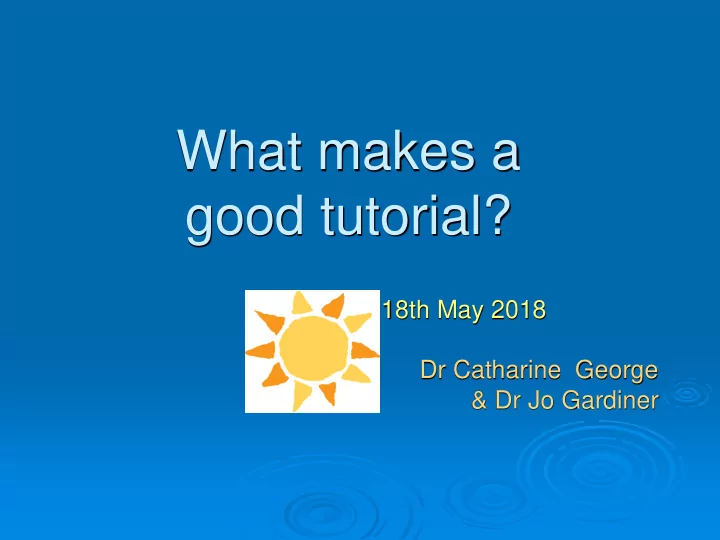

What makes a good tutorial? 18th May 2018 Dr Catharine George & Dr Jo Gardiner
What makes a good tutorial? Aims ➢ To encourage you to reflect and ➢ Challenge you to try something new ➢ To review some tools ➢ To enthuse you
Aims and objectives ➢ Aims: are general ➢ Objectives: are specific
What makes a good tutorial? Objectives • Defining aims & objectives • Assessing Trainees learning needs • Engaging our trainees • Using domains of learning • Considering different teaching methods.
Helps you ➢ Define what you are trying to achieve (content) ➢ Decide how to deliver ( method) ➢ Helps keep you on track ➢ Can use to reflect if you got there ➢ Can use to evaluate
Task: ➢ What is the purpose of tutorials?
Educational cycle Diagram you may remember from SPESC?!
Task ➢ How do we identify learning needs throughout training?
How do we identify learning needs? Summary of ideas ➢ Kiddy ring (to identify prior experiences) ➢ Confidence rating scales: Manchester, Lanarkshire list, RCGP Condensed curriculum guide knowledge rating scale (Others - see bradfordvts.co.uk ➢ PEP (provided free by RCGP) ➢ COTs CBDs ➢ Debriefs - PUNs DENs ➢ RCA & PCA (Random / Problem case analysis) ➢ Joint surgeries & videos, OOH feedback ➢ MSF, PSQ, informal feedback from staff & patients, CSR ➢ SEAs, complaints ➢ Discomfort log ➢ prescribing or referral analysis ➢ Formative CSA feedback, AKT, CSA
Adult learning (Rodgers 1988) ➢ Conducive climate established ➢ Learning activities relevant to circumstances ➢ Learner’s past experiences used in process ➢ Engagement of learner in design of process ➢ Encourage learner to be self-directed ➢ Educator facilitative rather than didactic ➢ Individual learner’s needs and styles taken into account
How to engage the trainee? ARCS model of motivation (Keller1987) “ hook” & stimulate attitude of enquiry ➢ Attention ➢ Relevance to learners needs ➢ Confidence empower self belief - can do it! ➢ Satisfaction enjoy & make a difference personally
Task ➢ Think of a recent tutorial… ➢ What do you think was the “hook”?
Domains of learning knowledge skills attitudes
Domains of learning Blooms taxonomy of Learning Objectives • Three hierarchical models are used to classify educational learning objectives: 1. Cognitive = Knowledge is gained 2. Psychomotor = Skills are acquired 3. Affective = Attitudes are changed • Useful when trying to identify learning objectives or outcomes for a tutorial. 14
Cognitive (Knowledge) Domain Diagram from Vanderbilt University for Teaching 15
Affective (Attitude) Domain • Unlike knowledge cannot be picked up from books /internet • More nebulous & hardest to evaluate. • attitudes are important part of GP curriculum of learning! 16
Psychomotor (skills) Domain • The conscious competence learning model • How we acquire a skill 17
Task ➢ Which domain did your tutorial focus on? knowledge skills attitudes ➢ How did you or could you have got into the other domains?
Domains of learning - Summary knowledge 1. Cognitive = Knowledge 2. Psychomotor = Skills 3. Affective = Attitudes skills attitudes • Useful when formulating learning objectives or outcomes • Checklist to reduce risks of overlooking some vital aspect & encourages a more holistic approach. Helps us identify where trainees are in the learning process & • consider how to move them onto the next level. • Can be used for planning the learning process itself - selecting methods/ activities to match the objectives. 19
Miller’s pyramid of Clinical Competence does shows knows how knows
Task ➢ In your recent tutorial, which level were you aiming for or did you achieve? ➢ What methods would have worked to achieve these aims? ➢ How could you move your Trainee up a level? does shows knows how knows
What makes a good tutorial - Summary ➢ Defining aims and objectives ➢ Assessing learning needs ➢ Engaging the learner - hooks! ➢ Using domains of learning ➢ Considering teaching methods - depends on objectives
Recommend
More recommend